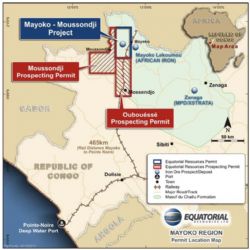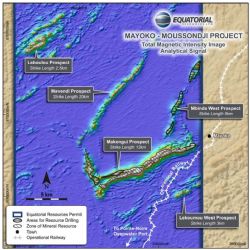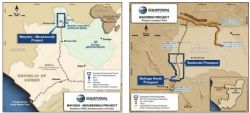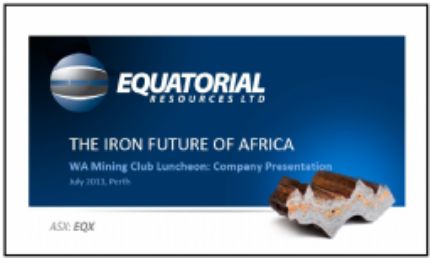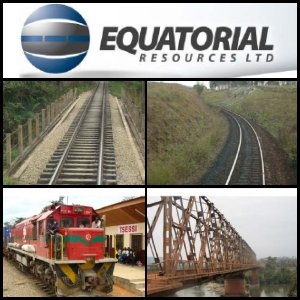
Mayoko-Moussondji Project Update
Perth, June 14, 2013 AEST (ABN Newswire) - Equatorial Resources Limited ( ASX:EQX) is pleased to release an update on activity at the Company’s 100% owned Mayoko-Moussondji Iron Project (“Mayoko-Moussondji” or “the Project”) in the Republic of Congo (“ROC”).
ASX:EQX) is pleased to release an update on activity at the Company’s 100% owned Mayoko-Moussondji Iron Project (“Mayoko-Moussondji” or “the Project”) in the Republic of Congo (“ROC”).
SCOPING STUDY WORK COMPLETED
Equatorial’s Project Management team under the supervision of Mr Rainer Dreier has completed the feasibility studies and design work for the Scoping Study for Mayoko-Moussondji. The Scoping Study will model Equatorial’s previously announced staged development plan (refer ASX announcement 20 March 2013) and will be based on the maiden indicated and inferred JORC compliant hematite resource announced in February 2013 of 102 million tonnes at 40.6% Fe (refer ASX announcement 4 February 2013). The Scoping Study is aimed at demonstrating the Project’s ability to rapidly commence production of a premium iron ore product using existing transport infrastructure with relatively modest initial capital investment.
Work completed as part of the Scoping Study includes:
- Resource modelling by CSA Global;
- Mine plan study by Orelogy Pty Ltd;
- Tailing Storage Feasibility Study by Golders Associates;
- Metallurgical testing and Processing Plant design by John Clout & Associates;
- Rail Feasibility Studies under the supervision of Equatorial’s rail studies manager Mr. John Dorotich; and
- Port stockpiling and loading plan by Camco Dreico Industrial Services.
WORLEYPARSONS APPOINTED
WorleyParsons Limited (“WorleyParsons”) has been appointed to perform an independent review and gap analysis of the Scoping Study completed by Equatorial’s Project Management team. As part of their review WorleyParsons will also provide optimisation input to the Scoping Study and develop a final estimate of the expected capital cost and operating costs of the Project.
WorleyParsons are a leading global provider of technical, project and operational support services to the resources industry with significant expertise and experience in the design, development and delivery of iron ore projects globally. The report to be prepared by WorleyParsons will include the following components of Equatorial’s Scoping Study:
- Latest optimisation, mining schedule and mining costs;
- Optimal mine life;
- Stockpiling and tailings storage management;
- Beneficiation plant, equipment and flow sheet;
- Load out arrangements for rail;
- Planned use of the existing rail transport system and staged rail enhancement program; and
- Development plan for a vessel loading arrangement at the port of Pointe-Noire.
A summary of the results of the Scoping Study is expected to be published by Equatorial at the end of June 2013.
METALLURGICAL TESTING PROGRAM RESULTS
Equatorial's metallurgical testing program is being conducted under the supervision of the Company's Chief Metallurgical Consultant and highly experienced iron ore metallurgist Dr John Clout at the metallurgical testing laboratories of Nagrom near Perth, Australia. Detailed metallurgical test work in support of the resource definition work has been previously reported to the ASX for each of the Colluvial Hematite, Friable Hematite and Hard Hematite material types (refer ASX announcement 4 February 2013, 26 April 2012 and 16 October 2012 for details) as well as Davis Tube Recovery ("DTR") results for the Magnetite material (refer ASX announcement 24 April 2012 for details).
The flowsheet for Equatorial's proposed Processing Plant for Mayoko-Moussondji is designed to treat the hematite mineralisation types and employs a typical Pilbara de-sanding circuit comprising scrubbing, wet screening and then two stages of gravity separation using an upcurrent classifier and a Wilfley Table to simulate spirals. Previous test work has demonstrated the ability to produce a premium high grade fines product of 64% Fe with low levels of impurities with high mass recovery.
Metallurgical test work required for Equatorial's Scoping Study has now been completed. Final stages of the program focused on potential design changes to the proposed process flowsheet to improve efficiency and to maximise product quality and mass recovery. Recent metallurgical test work conducted on the scrubbed -1 mm fraction of Friable Hematite bulk samples produced the following results:
- Material with an average head grade of 43.1% Fe upgraded to a premium 66.7% Fe high grade fines product at a 48% mass recovery; and
- Flowsheet modifications resulted in an improvement in total head mass recovery from the previous result of 63.7% Fe at 49.5 % mass recovery to 64.3% Fe at 61.9% mass recovery, an overall improvement in total mass recovery of 12.4%.
These recent results suggest a higher mass recovery and product grade may be achieved than previously estimated through the use of wet magnetic separation-gravity process using scrubbing, wet screening followed by LIMS, MIMS and Wilfley Tabling of the -1 mm fraction. This work is being assessed as part of the optimization process and any resulting design changes will be incorporated into the final outputs of the Scoping Study for Mayoko-Moussondji.
CO-OPERATION WITH EXXARO
Exxaro Resources Limited (“Exxaro”) is developing the Mayoko-Lekoumou Iron Project which lies immediately adjacent to Equatorial’s 100% owned Mayoko-Moussondji Iron Project in the Republic of Congo. Equatorial and Exxaro have agreed to co-operate on a range of operational activities to improve efficiencies and to reduce the cost of services for the Mayoko-Moussondji project.
Cooperation arrangements have now been established in relation to the following:
- The use of the Leghala Airstrip which is operated by Equatorial and was recommissioned by the Company in 2012;
- Shared used of charter flights between Mayoko and the cities of Pointe-Noire and Brazzaville;
- The shared use of Equatorial’s sample preparation laboratory at Mayoko;
- The shared use of medical support facilities in the Mayoko region; and
- Co-investment in regional community development initiatives.
Aside from the clear benefits to the companies in sharing operational resources, Equatorial has identified significant opportunities for development synergies particularly in relation to the refurbishment, upgrade and shared use of rail and port transport infrastructure that services the Mayoko iron projects. Equatorial continues to explore collaboration initiatives with Exxaro over these key items of project development and is encouraged by the government’s participation to ensure consistency and transparency of mining convention terms and the policies of access to, and investment in, state-owned infrastructure.
As a result of Exxaro’s rapid development progress at its Mayoko project and the on-going information exchange between the two companies, part of WorleyParsons’ independent review of Equatorial’s Scoping Study has been to assess how best Equatorial’s development plan can be adapted to align with Exxaro’s project development activities particularly in relation to the design and operational plans for the existing rail infrastructure network and port facilities that are available to service both projects.
ENVIRONMENTAL AND SOCIAL IMPACT ASSESSMENT
Equatorial has completed its Environmental and Social Impact Assessment Study (“ESIA”) for Mayoko-Moussondji. The ESIA was completed by local environmental consultancy Eco Durable based on the baseline work conducted by the Company’s environmental consultants SRK and Genivar. The ESIA is an extensive study that includes the results of more than 12 months of environmental monitoring programs, field surveys to understand flora and fauna of the Project, ecosystem sensitivity assessments, a detailed community engagement plan, socio-economic surveys, and a review of the livelihood restoration requirements for communities directly affected by the Project. The study was prepared within the framework of the Terms of Reference for the ESIA that was drafted by a joint team of scientists from SRK, Genivar and Eco Durable and were formally approved by government during 2012.
Numerous stakeholder meetings and workshops were undertaken as part of the ESIA, at local, regional and national levels, in line with Equatorial’s strong corporate focus on the environmental and social aspects of the Project. The results of this stakeholder engagement process were extremely positive, highlighting the strong levels of community and governmental support for the Project.
The completion of the ESIA represents the successful achievement of a major development milestone for the Project. The ESIA has now been lodged with the ROC government for approval. The approval of the Project’s ESIA is a pre-requisite to the granting of a Mining Permit under the ROC Mining Code.
MAYOKO PROSPECTING PERMITS
In December 2011 Equatorial was granted 100% ownership of two new Prospecting Authorisations for iron over areas surrounding Mayoko-Moussondji (refer ASX announcement dated 8 December 2011). The Moussondji Prospecting Permit is located directly to the East of Mayoko-Moussondji and the Oubouéssé Prospecting Permit is immediately to the South. The Permits cover areas within the Chaillu Massif region and are considered highly prospective for iron mineralisation similar to Mayoko-Moussondji, Exxaro’s Mayoko project and the nearby Zanaga iron project being developed by GlencoreXstrata.
Under the ROC Mining Code the Prospecting Authorisations gave Equatorial the right to conduct reconnaissance type exploration for iron and provide the right for the Company to apply for the conversion of the Prospecting Authorisations into exclusive Exploration Licenses in the event of successful exploration results during the Prospecting phase.
During 2012 Equatorial conducted reconnaissance exploration work and ground mapping on the Moussondji Prospecting Permit and the Oubouéssé Prospecting Permit. This work identified numerous occurrences of hematite mineralisation at surface. An extensive surface rock sampling campaign followed and provided confirmation of the initial ground work with assay results returning grades exceeding +60% Fe from certain areas within both permits. As a result of the positive exploration results and the identified potential to add significant tonnes to the company’s existing resource base at Mayoko-Moussondji, Equatorial has made an application to the ROC government to convert areas within the two Prospecting Authorisations into Exploration Licenses as provided for under the ROC Mining Code.
QUARRY LICENCE
Numerous deposits of high quality laterite exist within the Mayoko-Moussondji project area and have the potential to supply the Company with large quantities of construction material during the development phase of the Project, particularly for road building and infrastructure construction.
In June 2013 Equatorial submitted quarry licence applications to the ROC Mining Ministry over five areas within Mayoko- Moussondji . Under the ROC Mining Code a quarry license (“Mining Authorization”) is issued by decree from the Mining Minister and provides the holder the exclusive right to operate a quarry or small mine operation. Larger scale mining activities, such as those contemplated in the development of Mayoko-Moussondji, require the granting of a Mining License (“Mining Permit”) which is issued by the ROC Council of Ministers. The granting of the quarrying licences would represent a significant cost saving to Equatorial for the construction phase of the Project.
DRILLING PROGRAM COMPLETED
Equatorial has completed the current drilling campaign at Mayoko-Moussondji having successfully achieved the objectives of the program. The drilling program included the completion of a total of 58,761 metres of drilling in 505 holes at the project comprising 96 Diamond holes for 13,644 metres and 409 Reverse Circulation holes for 45,117 metres.
Drilling was carried out under a contract with Wallis Drilling of Australia.
The drilling campaign has been highly successful with drilling conducted during 2012 delineating the Company’s maiden JORC resource for Mayoko-Moussondji (refer ASX announcement 4 February 2013). The maiden indicated and inferred resource of 767 million tonnes at 31.9% Fe includes a hematite component of 102 million tonnes at 40.6% Fe. The initial resource was based on data from 43,743 metres of drilling from 383 drill holes and extended over a strike length of 16km.
The maiden resource has formed the basis of the Scoping Study for Mayoko-Moussondji and is expected to underpin the Project. As a result of the completion of the current drilling campaign the Company expects a significant reduction in exploration expenditure.
The drilling completed since the estimation of the maiden resource has delineated further mineralisation along strike at the Makengui Prospect and also along the previously untested Mbinda West Prospect. Assays remain pending for recently completed drilling and once received will be used to prepare an updated resource estimate. The approximate 15,000 metres of drilling completed since the maiden resource is expected to increase the Hematite and Magnetite Resource. Potential exists to continue to increase the resource base at Mayoko-Moussondji in future if required. Drilling has been completed over only 21km of more than 46km of identified magnetic strike at the Project.
A revised resource estimate is expected to be announced by the end of the 2013 calendar year.
To view diagrams and charts, please visit:
http://media.abnnewswire.net/media/en/docs/ASX-EQX-638725.pdf
Contact
John Welborn Managing Director & CEO
Telephone: +61-8-9466-5030
Email: info@equatorialresources.com.au
Web: www.equatorialresources.com.au
| ||
|



